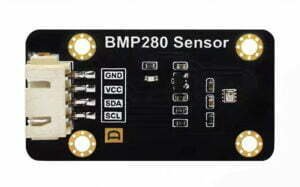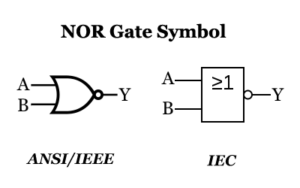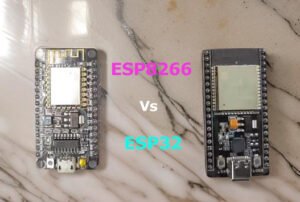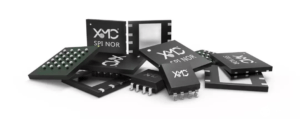The LIS2DW12 and LIS2DH12 are both high-performance MEMS (Micro-Electro-Mechanical Systems) accelerometers designed and manufactured by STMicroelectronics. These accelerometers find application in various industries, such as wearable devices, gaming controls, industrial automation, and medical equipment. This article provides an in-depth comparison of the LIS2DW12 and LIS2DH12, discussing their specifications, features, applications, and more.
Overview of LIS2DW12 vs LIS2DH12
The LIS2DW12 is a low-power, high-performance 3-axis accelerometer that consumes less than 50 μA in low-power mode.
The LIS2DH12 is a low-power, high-performance 3-axis accelerometer optimized for low noise and high sensitivity at low frequency.
Both accelerometers are designed to provide accurate and reliable measurements in their respective application areas, making them ideal for various industries and projects.
Specifications Comparison: LIS2DW12 vs LIS2DH12
Measurement Range and Output Data Rate
Both accelerometers have a measurement range of ±2, ±4, ±8, or ±16 g and an output data rate of up to 6.66 kHz.
Noise Density
The LIS2DW12 has a lower noise density of 90 µg/√Hz, while the LIS2DH12 has a noise density of 150 µg/√Hz.
Voltage Range
The LIS2DH12 has a wider voltage range of 1.71V to 3.6V compared to the LIS2DW12, which has a voltage range of 1.62V to 3.6V.
Shock Survivability
The LIS2DW12 has a higher shock survivability of 10,000 g compared to the LIS2DH12, which has a shock survivability of 2,000 g.
Features Comparison: LIS2DW12 vs LIS2DH12
Power Consumption
Both accelerometers have low power consumption, with the LIS2DW12 consuming less than 50 μA in low-power mode and the LIS2DH12 consuming less than 100 μA in normal mode.
Built-in Pedometer and Step Counter
The LIS2DW12 has a built-in pedometer and step counter, making it suitable for wearable devices and motion detection applications.
High Resolution
The LIS2DH12 has a high resolution of 16 bits, allowing for more precise measurements.
Applications Comparison: LIS2DW12 vs LIS2DH12
The LIS2DW12 is suitable for use in fitness and health monitoring devices, smartwatches, and motion-detecting products.
The LIS2DH12 is ideal for use in gaming controls, virtual and augmented reality devices, drones, and industrial automation.
Package and Pinout Comparison: LIS2DW12 vs LIS2DH12
Both the LIS2DW12 and LIS2DH12 are available in 12-lead plastic LGA packages and 16-lead plastic LGA packages.
The pinout for both the LIS2DW12 and LIS2DH12 accelerometers are similar, including:
- INT1: Interrupt 1 output pin.
- INT2: Interrupt 2 output pin.
- GND: Ground connection.
- VDD: Power supply input (1.71V to 3.6V).
- CS: Chip select for SPI communication (optional if using I2C).
- SCL/SPC: Serial clock or serial peripheral input for I2C/SPI communication.
- SDA/SDI/SDO: Serial data input/output for I2C/SPI communication.
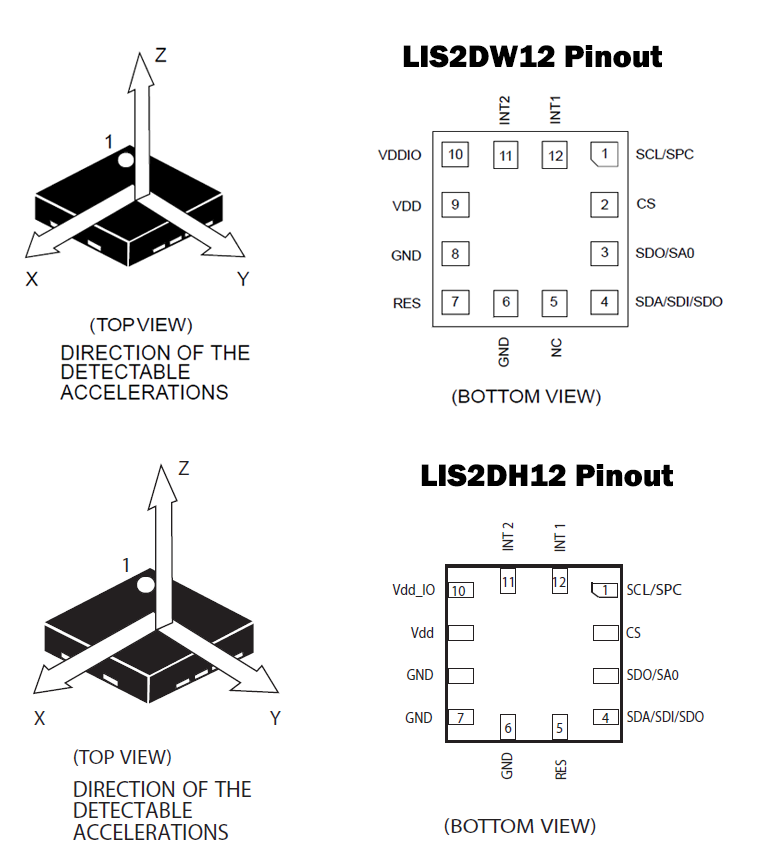
Block Diagram Comparison: LIS2DW12 vs LIS2DH12
The LIS2DW12 and LIS2DH12 accelerometers share comparable block diagrams, which comprise an analog front-end (AFE), a digital signal processor (DSP), and an I2C/SPI interface.
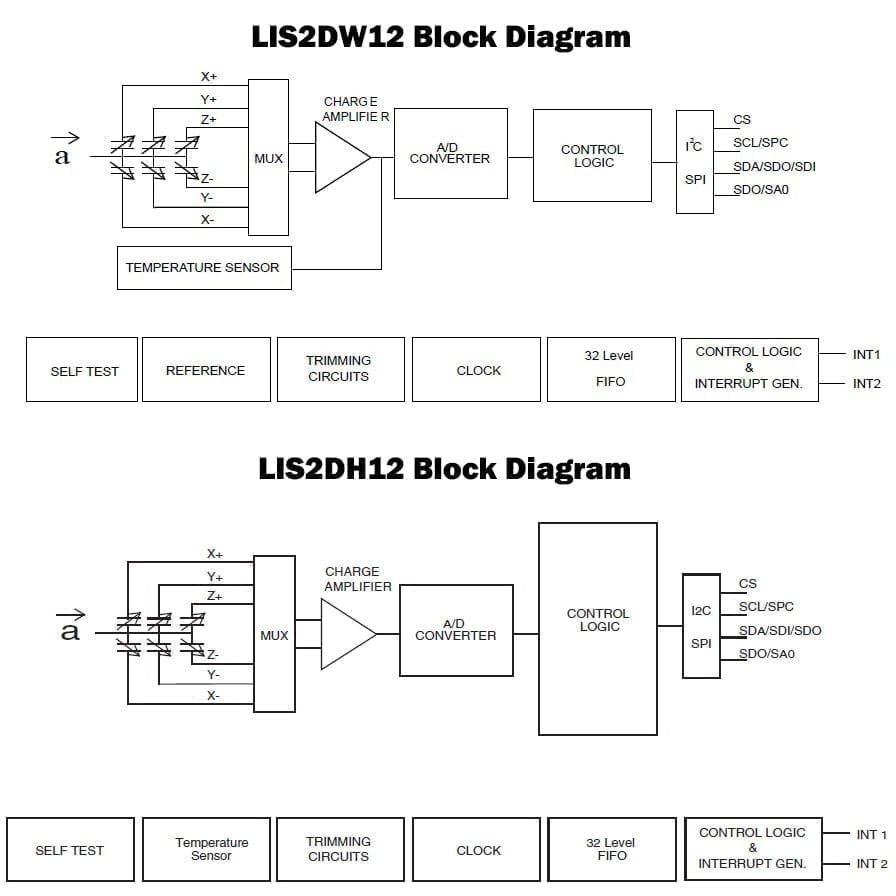
Connection Circuit Comparison: LIS2DW12 vs LIS2DH12
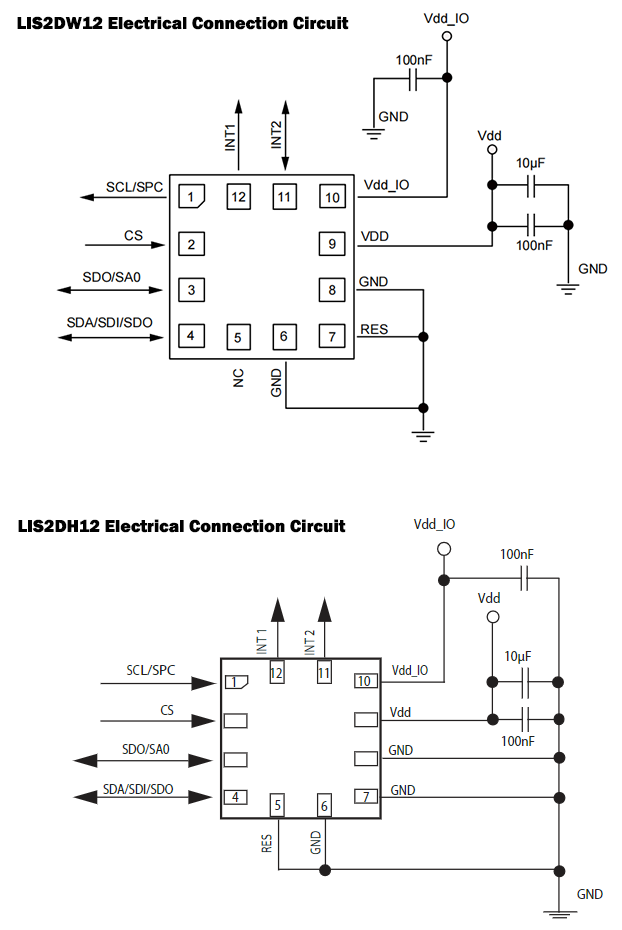
Alternative Parts for LIS2DW12 and LIS2DH12
Alternative Parts for LIS2DW12:
Alternative parts for the LIS2DW12 include the LIS2DWLTR, LIS2DW12TR, LIS2DW12P, LIS2DW12D, and LIS2DW12DL.
Alternative Parts for LIS2DH12:
Alternative parts for the LIS2DH12 include the LIS2DH12TR, LIS2DH12P, LIS2DH12D, LIS2DH12DL, and LIS2DE12.
Selecting the Right Accelerometer: LIS2DW12 vs LIS2DH12
When choosing between the LIS2DW12 and LIS2DH12, it is crucial to consider the specific requirements and applications of your project. The LIS2DW12 is better suited for wearable technology, while the LIS2DH12 is best for industrial automation and gaming controls. Additionally, the LIS2DW12 provides built-in functionality for pedometer and step-counting applications, making it ideal for fitness and health monitoring devices.
Conclusion
In summary, the LIS2DW12 and LIS2DH12 are both high-performance MEMS accelerometers that provide unique features and specifications, making each suitable for specific applications. The LIS2DW12 is ideal for wearable devices and health monitoring, while the LIS2DH12 is better suited for industrial automation and gaming controls. By carefully considering the specifications, features, and application requirements, you can select the right accelerometer for your project.

